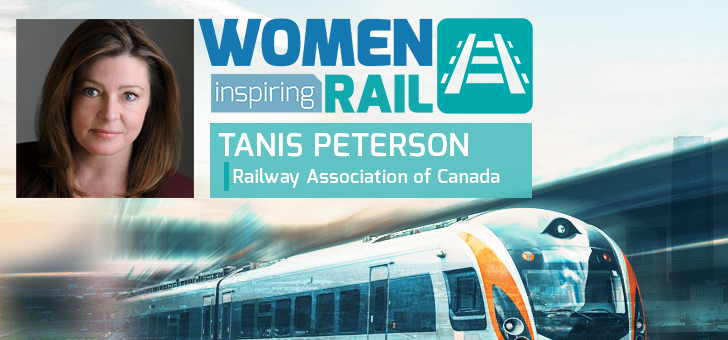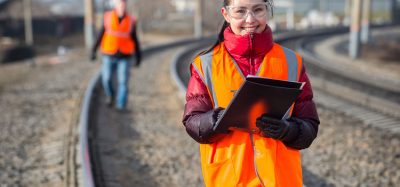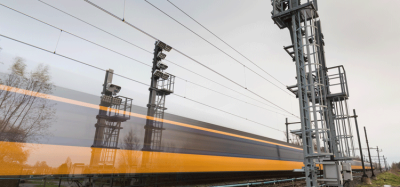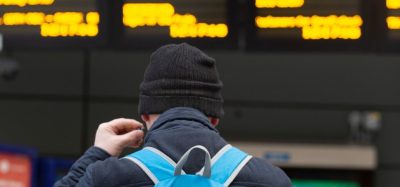Women Inspiring Rail: Q&A with Tanis Peterson, Senior Director of Operations and Regulatory Affairs, Railway Association of Canada (RAC)
Posted: 19 August 2019 | Global Railway Review | No comments yet
For our next Women Inspiring Rail instalment, Tanis Peterson, Senior Director of Operations and Regulatory Affairs at the Railway Association of Canada (RAC), talks about her fascination with the application of new technologies in the railway industry and how she hopes more females will recognise rail as an exciting career path.


How did your career in rail begin and what does your current job involve?
To this day, I usually say in a joking way that I still don’t know what I want to be when I grow up. It is fair to say that back in the year 2000, when I began my career as a railway conductor for Canadian Pacific Railway, I had no idea what amazing opportunities the railway industry would provide for me.
Today, I am the Senior Director of Operations and Regulatory Affairs for the Railway Association of Canada (RAC). We represent close to 60 freight and passenger railway companies – railways that transport more than 84 million passengers and more than $310 billion worth of goods across our country each year. RAC also counts a growing number of industrial railways and railway supply companies in its associate membership.
It is fair to say that back in the year 2000, when I began my career as a railway conductor for Canadian Pacific Railway, I had no idea what amazing opportunities the railway industry would provide for me.
My operations and regulatory affairs team based out of Ottawa, the capital city of Canada, collaborates with industry and works with governments across the country to ensure that Canada’s rail sector remains competitive, sustainable, and most importantly, safe. On behalf of industry, we work with government in developing new regulations, rules and standards. We also assist our members with emergency response, car loading securement, telecommunications, and more.
My team works closely with the policy and communications teams, principally to provide expertise in the technical aspects of railway operations.
What aspects of your job do you find the most challenging/rewarding, and why?
Perhaps the most challenging aspect of my current role is simultaneously working with the many different railway businesses represented by the RAC. Our membership includes intercity passenger, commuter, tourist, shortline and Class I freight railways.
Each subsection of our industry has distinct needs and priorities that we work to advance. There is a steep learning curve involved in mastering them all.
The element of this role that I find most rewarding is participating in the improvement and advancement of an industry that makes an essential contribution to our society, and that has made incredible strides in safety, environmental, and operating performance throughout my career.
The element of this role that I find most rewarding is participating in the improvement and advancement of an industry that makes an essential contribution to our society, and that has made incredible strides in safety, environmental, and operating performance throughout my career.
For example, since 1990, Canadian railways have reduced their emissions intensity by 40 per cent, even as railway traffic increased by 80 per cent over the same period.
Since the year before I entered the industry, 1999, Canadian railways have reduced their accident rate by 43 per cent – a statistic even more remarkable when you consider that railway traffic increased dramatically over the same period.
Our industry has been able to drive astounding increases in safety performance because of a deep commitment to safety culture – which I have participated in throughout my entire career.
Unfortunately, some accidents do still occur. The vast majority of these are caused by trespassing on railway property or accidents at level crossings. At the RAC, we are actively targeting these issues through participation in initiatives like Operation Lifesaver, which I believe are extremely valuable.
What is it about the rail industry that are you most passionate about?
I am fascinated by the application of new technologies in the railway industry. Most people are not aware of the array of sophisticated technologies inside a modern train.
I am fascinated by the application of new technologies in the railway industry. Most people are not aware of the array of sophisticated technologies inside a modern train.
We use anti-idling technologies that cut needless emissions generated during down period. Fuel management software gives engineers real-time information on how they can operate locomotives in the most fuel-efficient way possible. Certain on-board technology goes a step further and, when activated by an engineer, automatically controls the locomotive’s throttle and dynamic brake (using real-time data on train position, length, weight and more) to minimise fuel consumption.
Technology has enabled major environmental improvements in the rail industry, but we are equally focused on harnessing technology to increase safety performance.
Although we are very proud of our record in implementing new technologies, there is great optimism in the industry about the future potential of these and other technologies. I am excited to see how much our industry can achieve in the next 20 years.
Our members are rolling out thousands of sensors to help them predict maintenance needs and prevent incidents from occurring. Railways have begun using tie rating technology, a 3-D image measurement system, to assess track ties conditions. Railcars equipped with ground penetrating radar technology provide detailed assessments of ballast and subgrade conditions. By accumulating mountains of data from wheels, rails, cars, locomotives and trains, railways can now use predictive analytics to perform maintenance before issues arise. This technology has already produced incredible results, for example in reducing wheel bearing failures.
Although we are very proud of our record in implementing new technologies, there is great optimism in the industry about the future potential of these and other technologies. I am excited to see how much our industry can achieve in the next 20 years.
What has been your biggest achievement/proudest moment so far in your rail career?
Although we are very proud of our record in implementing new technologies, there is great optimism in the industry about the future potential of these and other technologies. I am excited to see how much our industry can achieve in the next 20 years.
There are several episodes that stand out in my mind. The proudest moment of the early phase of my career was when I was first put in charge of a freight train. The first time that you are directly responsible for thousands of tonnes of goods sitting behind you, and the safety of your co-workers, is an unforgettable experience. I have talked about this with many colleagues over the years and have yet to find anyone who disagrees.
Another moment that brought me real satisfaction was years later, when I taught my first course qualifying new conductors. Stepping into that classroom for the first time, I was reminded of my days as a student and trainee. Railroading is a highly technical profession that is well understood by relatively few people – you cannot help but feel proud when you have progressed to the point where you can certify new railroaders.
The proudest moment of the early phase of my career was when I was first put in charge of a freight train. The first time that you are directly responsible for thousands of tonnes of goods sitting behind you, and the safety of your co-workers, is an unforgettable experience.
Teaching others fills you with the same sense of responsibility you feel when you are put in charge of a train. After all, your students will be responsible for the safety of other people on a daily basis. I look at my job today, working across the industry and with the Federal Government to improve railway safety, as another phase of that progression I have been working toward for 20 years.
I must give an honourable mention to one other moment: the first time I sat behind the throttle of a commuter train, and we pulled up to our first platform. I stopped the train in perfect position for our customers to disembark and, as simple as that sounds, I remember that moment to this day.
How has the rail industry evolved since you joined? What have been the biggest changes?
The uses of technology I described earlier certainly stand out as the major evolution from 1999 to present. Our members are digitalising operations from top to bottom – compared to when I joined the industry, that translates to more data, less paper, and less human error.
I have also been pleased to see evolution in the industry in terms of diversity. I see more female railroaders today than when I began my career, and I hope that trend will accelerate further.
One of our members recently announced the hiring of a Chief Data Officer – the first time that title has been used in the organisation’s history. That is just one example of an industry-wide trend: the recognition that railroads create enormous amounts of data every day, and technology can use that data to enable concrete operational improvements. When I joined the industry, there was certainly less appreciation of how the digital revolution would transform railroading.
The other evolution I would highlight is the industry’s ironclad commitment to safety culture. Safety is the top priority across all aspects of our members’ operations. One example of evolution in this area is our outreach with first responders. Our members now train thousands of first responders every year to respond to railway incidents. With a focus on the transportation of dangerous goods, we organise practical demonstrations, classroom sessions, and innovative approaches like virtual reality-based training sessions across North America. Our industry developed a mobile phone application that allows first responders to quickly and easily see what goods are on board a train.
I have also been pleased to see evolution in the industry in terms of diversity. I see more female railroaders today than when I began my career, and I hope that trend will accelerate further.
Who within the rail community has been an inspiration to you, and why?
I have also been pleased to see evolution in the industry in terms of diversity. I see more female railroaders today than when I began my career, and I hope that trend will accelerate further.
We are fortunate to have many great leaders in the railway industry who have inspired me throughout my career. As a Canadian, I am proud that we punch above our weight in terms of the size and sophistication of our rail network. Many of the techniques that have revolutionised the rail industry were put into practice in Canada before they were implemented at American railroads. If you look at American Class Is, for example, you will see many former Canadian railroaders leading major change – applying lessons they learned in Canada.
On a personal level, the first person who supported my interest in the industry was a service area manager in Montreal. At the time, I had experience as a conductor and engineer, but was unsure what else the rail industry could provide me. When I shared these thoughts with him, he explained the numerous avenues that exist for experienced railroaders to advance their careers. Most importantly, he told me that I had great potential in this industry, and essentially, I could follow the career path my heart desired.
This was very inspiring, and at the time, working in an all-male environment, I might have needed that insight. I felt appreciated, motivated, and believed I could offer this industry value.
What can be done to diversify the workforce in the rail sector? What advice would you give to those thinking about pursuing a career in rail?
First, we need to continue to spread the word to young people that a career in rail is an amazing option. Many students, especially women, are not aware of the diverse and exciting opportunities that exist in rail.
We need to continue to spread the word to young people that a career in rail is an amazing option. Many students, especially women, are not aware of the diverse and exciting opportunities that exist in rail.
For example, we need to ensure young female technologists realise there are career opportunities in rail. As railways innovate and pursue technological advances, they open the door for employees and partners in career fields not traditionally associated with railways, such as data analytics.
Second, I would strongly encourage anyone thinking about pursuing a career in rail to look into the League of Railway Women (LRW). I am the proud President of the LRW, with membership from every corner of North America. I believe the networking and mentorship opportunities we provide can make a huge difference in the career of a young person considering a career in rail.
Beyond mentorship, there are two specific LRW initiatives I’d like to highlight.
Each year, the LRW awards the Connie Sumara Memorial Scholarship to a qualified student from around the rail industry who is pursuing an undergraduate or postgraduate degree. If that describes you, I highly recommend that you apply for the scholarship.
Second, young people considering a career in rail should read about past winners of the LRW Railway Woman of the Year award. The LRW presents this award to a woman who is considered a leader by her peers. It is so important for women who are more junior in their careers to have strong role models. The LRW Railway Woman of the Year is someone who demonstrates vision and creativity, takes initiative, provides guidance in a leadership role, overcomes challenges with innovative solutions, and brings excellence to her organisation and community. These women inspire me, and I am certain that they will inspire young aspiring railroaders.
If you would like to take part in the Women Inspiring Rail series, or would like to nominate a colleague to part, please email: Craig Waters, Editor, Global Railway Review.








